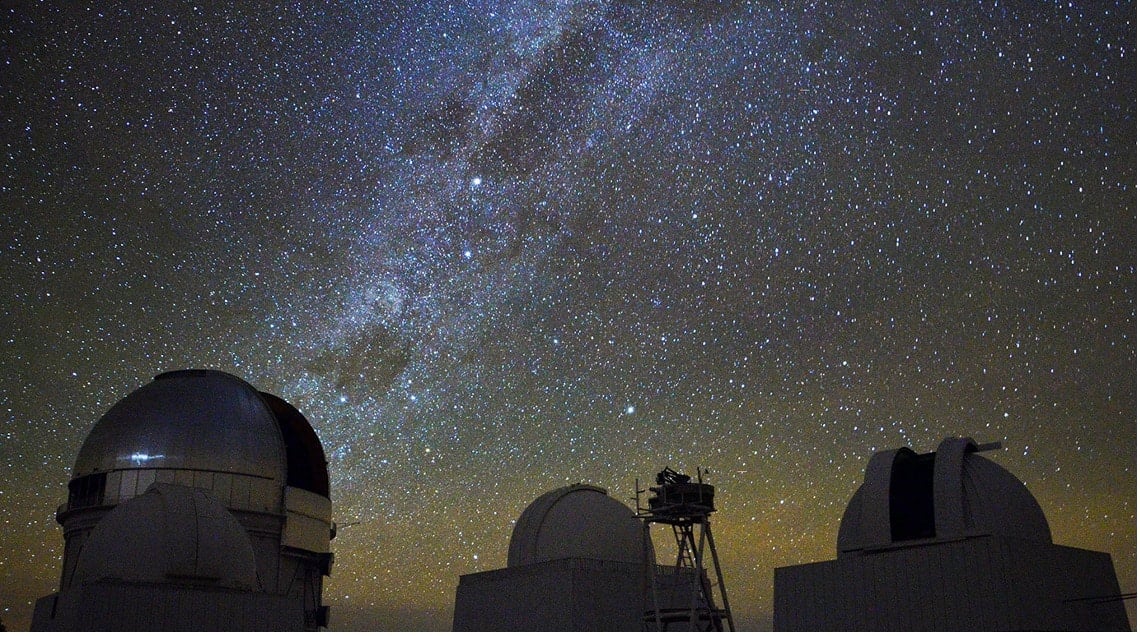(CN) — Hundreds of scientists have been working for years on a new map of everything in the universe: the planets, the stars, the black holes, the bits and pieces of rock and ice floating in the lonely emptiness of space — in short, all the stuff.
Well, not quite all the stuff. For one thing, the new analysis only looks in one direction in space, so what we're talking about here is ten percent of the sky, as seen from earth. And the map doesn't go to the very edges of the universe, because the universe, as you may have heard, is infinite. And the map isn't of how the universe is now, but of how it looked billions and billions of years ago.
Think of it as a really, really old photograph of a really, really big chunk of space, one that includes not just matter we can see, but matter we can't see, dark matter, and know very little about, even though it makes up the vast majority of all substance in the universe.
The new analysis, published on Tuesday as a set of three articles in the journal Physical Review D, draws on data from two massive cosmological surveys, each a very different portrait of the universe. The first is the Dark Energy Survey, which studied the sky for more than six years from a mountaintop in Chile with a high-powered optical telescope. This telescope measures slight distortions in the shapes of galaxies, caused by something called "gravitational lensing." As light travels through space, it can bend slightly as it passes objects with lots of gravity, and can therefore show astronomers where both regular and dark matter exist, since they both exert gravity.
The second survey was from a telescope in the South Pole, which measures cosmic microwave background — faint traces of leftover light, first emitted more than 13 billion years ago, when the universe was only thousands of years old. This telescope also reveals gravitational lensing, but in this case, it's showing distortions in the cosmic microwave background.
"The two observations tell us very different things about universe," said Eric Baxter, a cosmologist and professor at the University of Hawaii, and one of the papers' co-authors. "But they provide complementary observations on the distribution of matter in the universe."
The result, according to Baxter: "We think we have one of the most precise and unbiased maps of matter distribution."
But the map raises at least one very big question.
Scientists have developed something called the "standard cosmological model," a theoretical model of how the universe was born (starting with the big bang), how it developed, and what it's made up of. There's the not-very-mysterious-at-all normal matter, the somewhat mysterious dark matter, and the very mysterious dark energy. We don't know what dark energy is, but we think it has something to do with why the universe's expansion is accelerating.
"We’ve got this theory that works, but we don’t understand it," said Baxter. "It’s a very simple theory. The equations work, but we have no insight into what these two things are."
The theory explains a lot about what we think we know. But certain recent observations made in the last five years have suggested that we're missing something.
One of the biggest issues is clumpiness: that is, how clumped together matter is in the universe, or how unevenly distributed it is. The standard cosmological model suggests that the universe is fairly clumpy. And observations of the universe from more than 10 billion years ago appear to confirm this model. But more recent (still billions of years ago) observations show a less clumpy than expected universe — in recent eons, matter is more evenly distributed.
This suggests one of two things is wrong: either the standard cosmological model, or our understanding of astrophysical processes — the laws that govern the cosmos.
Should it turn out to be the former, according to Baxter, it could be "something totally new, totally crazy." For example: "Maybe the dark matter isn’t totally dark, maybe it actually interacts with normal matter. That could change the distribution of matter." Such a discovery, said Baxter, "would be a big deal, with implications for our understanding of fundamental physics."
Or perhaps it is that our understanding of astrophysical processes is off: for example, perhaps supernovae (when stars explode) are less powerful than we thought; or maybe active galactic nuclei (supermassive black holes with jets that spit out energy from jets) are more powerful than previously believed.
"These would be changes with our understanding of astrophysical processes, but not revolutions in our understanding of physics," Baxter said.
Either way, Baxter and the other researchers hope this kind of analysis will be replicated and improved upon.
"This is kind of a precursor to the next generation of measurements," Baxter said.
“I think this exercise showed both the challenges and benefits of doing these kinds of analyses," said Chihway Chang, an astrophysicist and one of the lead authors of the study. "There’s a lot of new things you can do when you combine these different angles of looking at the universe.”
Subscribe to Closing Arguments
Sign up for new weekly newsletter Closing Arguments to get the latest about ongoing trials, major litigation and hot cases and rulings in courthouses around the U.S. and the world.









